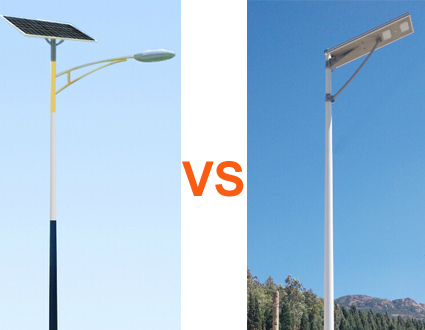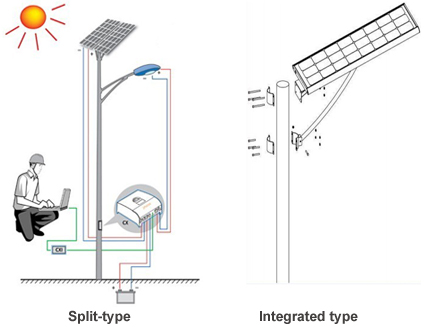BETTER TOUCH BETTER BUSINESS
Contact Sales at Litel Technology
With the rapid development of photovoltaic and LED lighting, solar lighting products are more and more popular. The perfect combination of photovoltaic and high-efficiency LED brings very good economic benefits upon lighting, also great environment benefits with the clear renewable solar energy. Now we get two generations solar LED lights according to the different structural design: the first generation split-type solar street lights and the second generation integrated solar street lamps.

What are the pros and cons of these two kinds of solar lights? Let’s do some comparisons as below:
A. Battery
Battery is a very important component which storage and supply power for the solar street lights, it decides the service life of the street light and rainy days of standby time.
The split-type solar street lamps use lead-acid batteries, and the integrated solar street lamps use lithium battery. Lithium battery charge and discharge times is 3 times of lead-acid batteries, so that the lithium battery have longer life span.(Now Litel use the high efficiency LiFePO4, which are more stable and with 5-6 years long service life.)
For the lead-acid batteries, when the temperature is below 5 ℃, its capacity will be reduced. When the temperature is below – 10 ℃, the electrolyte will be frozen and the battery will disabled temporarily. For the lithium battery, it can work well when the temperature not lower than -20 ℃, and the capacity will not be reduced. When the temperature is below -20 ℃ -30 ℃, the capacity will has 30% reduction.
So we can see: the integrated solar street lights have longer life span, and with better performance when the temperature is low.
B. Price
The prices of split-type solar street lights are much more expensive about 40%-60 than the ones of integrated solar street light.
C. Installation
The speed of installation will affect the project installation costs.

We can see from the above installation diagram, to install the split-type solar street lights, we need to dig pits for cage and battery. Then we need to install solar panels, lighting lamp, fix all the kits, after all of these, we still have to wire inside to make the whole system work.
For integrated solar street lights, just 3 simple steps for installation : digging cage—-fixing thescrews of the lights—-erect the pole, installation done.
Installation summary: We have to take about 1-1.5 hours to install a split-type solar street light. For the integrated solar powered street lights, the solar panel, LED lamp, battery, smart sensor and controller are all in one box, very easy to install. They can be installed on the new pole or the old poles, even the walls are also ok. It help save lots installation time and costs.
D. Maintenance
For the traditional split-type solar street lights, when there is something wrong with the lights, manufacturers need to send technical personnel to the local repair. They have to do troubleshooting with thebattery, photovoltaic panels, LED lamp, wires etc. If the maintenance worker do not take enough spare parts, it will wasted much more time. On the other hand, some factories are not willing to send technical workers to installation location because of the high costs.
For all-in-one solar powered street lamps, the customers just need to send the whole integrated solar lamp to factory for maintenance, very easy and convenient.
Summary: The integrated solar powered street lamps have more advantages than the split-type solar powered street lights on the price, service life, installation and maintenance costs. Which is the reason why more and more people choose integrated solar lights.
Litel manufacture 6W-100W integrated solar street lamps, products have won lots clients all over the world. If you need more information about our products, please feel free to contact us,we will try our best to support you.
Copyright © 2025 Guangzhou Litel Technology Co.,Ltd. | All Rights Reserved
We are here to help you! If you close the chatbox, you will automatically receive a response from us via email. Please be sure to leave your contact details so that we can better assist